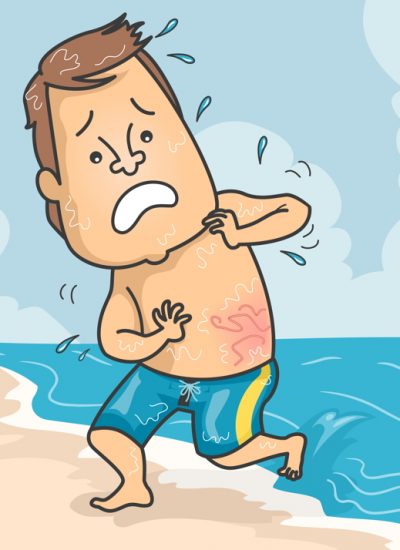
Tiny, near-invisible creatures called clinging jellyfish have made the summer miserable for many swimmers in New Jersey’s bay waters. We’ve got expert tips on what to do (and not do) in the event of a sting.
These non-native, transparent jellyfish (likely from the Pacific Ocean) were confirmed earlier this summer to have migrated from the Shrewsbury River to the Metedeconk River and further south into Barnegat Bay. Many have been spotted in the marshy sea grass as far south as Tices Shoal, a popular swimming and boating area off Island Beach State Park. The invaders likely arrived in New Jersey by hitching a ride on the algae-covered hull of an unsuspecting boat.
Unfortunately for swimmers, the jellyfish are hard to spot. They are about the size of a dime and sport long stringy tentacles. If you happen to get close enough, you may see tiny reddish-orange markings. A sting from these jellyfish causes excruciating pain. While native jellyfish stings are more itchy than painful, clinging jellyfish stings can be unbearable.
What should you do if they strike? We asked several avid sailors; each had a solution to share.
1. Apply Ice: Matt Ward, 53, of Toms River, wasn’t even in the water recently when he was stung. He was merely pulling up the anchor line of his sailboat moored in the waters off Seaside Park. “His tentacles wrapped completely around my arm,” says Ward, but he never even saw the body of the culprit. He immediately grabbed ice from his cooler and applied it to the sting. “Ice definitely helps,” he says. Five days later, the sting site was still red but the pain long gone.
2. Try Vinegar: Peter Maes, 23, of Brielle, has been sailing the Manasquan River and throughout Barnegat Bay virtually all his life. “I’ve been stung hundreds of times,” he claims. “It’s more itchy than painful but then, I have a high threshold for pain.” His remedy: apply vinegar to the sting site. “It takes away the itch,” he says.
3. The Medical Approach. A really bad sting may require some drugs. Hydrocortisone ointment can stop the itching, while an antihistamine can help with the swelling. Only rarely does a sting require a doctor’s attention; if so, he or she will likely prescribe a steroid.
4. Cover Up: Short of staying out of the water, a good way to avoid stings is to cover up. Wear tights, suggests Carolyn Kearny, 22. The Toms River native is a recent grad of the University of Pennsylvania, where she captained the sailing team. “Long sleeves, rash guards, tights, they all work,” she says.
5. Get Greasy: Slathering limbs in Vaseline or K-Y Jelly seems to do the trick, says Ed Harrison, 18, a junior sailing instructor at Shore Acres Yacht Club in Brick. He’s seen it done for some of his sailing students. “It was some mom’s idea,” says Harrison. “Then they apply their sunscreen on top.”
6. Just Say “No” to Urine: It’s a common myth that urinating on a jellyfish sting reduces the pain. It doesn’t work and it’s just plain gross. “Yeah, don’t do that,” says Matt Ward.
